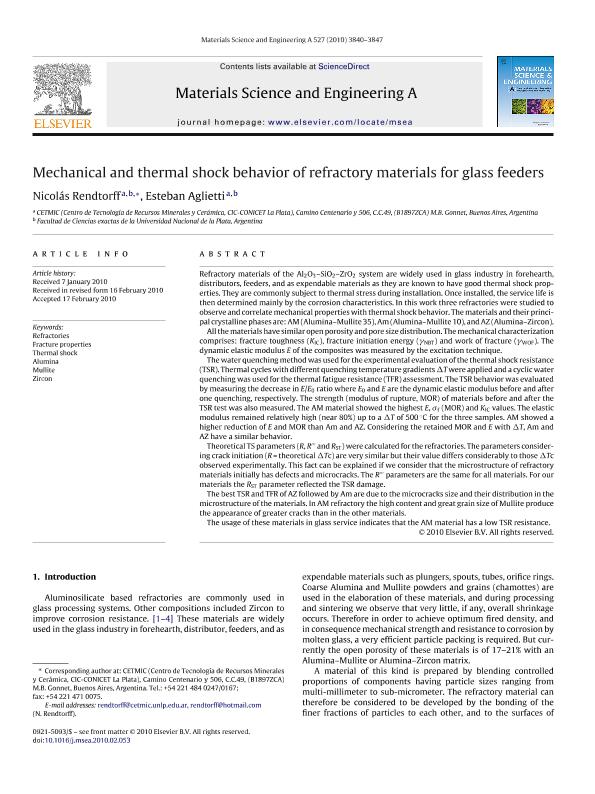Mostrar el registro sencillo del ítem
dc.contributor.author
Rendtorff Birrer, Nicolás Maximiliano

dc.contributor.author
Aglietti, Esteban Fausto

dc.date.available
2022-04-01T20:29:54Z
dc.date.issued
2010-06-15
dc.identifier.citation
Rendtorff Birrer, Nicolás Maximiliano; Aglietti, Esteban Fausto; Mechanical and thermal shock behavior of refractory materials for glass feeders; Elsevier Science SA; Materials Science and Engineering A: Structural Materials: Properties, Microstructure and Processing; 527; 16-17; 15-6-2010; 3840-3847
dc.identifier.issn
0921-5093
dc.identifier.uri
http://hdl.handle.net/11336/154205
dc.description.abstract
Refractory materials of the Al2O3–SiO2–ZrO2 system are widely used in glass industry in forehearth, distributors, feeders, and as expendable materials as they are known to have good thermal shock properties. They are commonly subject to thermal stress during installation. Once installed, the service life is then determined mainly by the corrosion characteristics. In this work three refractories were studied to observe and correlate mechanical properties with thermal shock behavior. The materials and their principal crystalline phases are: AM (Alumina–Mullite 35), Am (Alumina–Mullite 10), and AZ (Alumina–Zircon). All the materials have similar open porosity and pore size distribution. The mechanical characterization comprises: fracture toughness (KIC), fracture initiation energy (NBT) and work of fracture (WOF). The dynamic elastic modulus E of the composites was measured by the excitation technique. The water quenching method was used for the experimental evaluation of the thermal shock resistance (TSR). Thermal cycles with different quenching temperature gradients T were applied and a cyclic water quenching was used for the thermal fatigue resistance (TFR) assessment. The TSR behavior was evaluated by measuring the decrease in E/E0 ratio where E0 and E are the dynamic elastic modulus before and after one quenching, respectively. The strength (modulus of rupture, MOR) of materials before and after the TSR test was also measured. The AM material showed the highest E, f (MOR) and KIC values. The elastic modulus remained relatively high (near 80%) up to a T of 500 ◦C for the three samples. AM showed a higher reduction of E and MOR than Am and AZ. Considering the retained MOR and E with T, Am and AZ have a similar behavior. Theoretical TS parameters (R, R and RST) were calculated for the refractories. The parameters considering crack initiation (R = theoretical Tc) are very similar but their value differs considerably to those Tc observed experimentally. This fact can be explained if we consider that the microstructure of refractory materials initially has defects and microcracks. The R parameters are the same for all materials. For our materials the RST parameter reflected the TSR damage. The best TSR and TFR of AZ followed by Am are due to the microcracks size and their distribution in the microstructure of the materials. In AM refractory the high content and great grain size of Mullite produce the appearance of greater cracks than in the other materials. The usage of these materials in glass service indicates that the AM material has a low TSR resistance.
dc.format
application/pdf
dc.language.iso
eng
dc.publisher
Elsevier Science SA

dc.rights
info:eu-repo/semantics/openAccess
dc.rights.uri
https://creativecommons.org/licenses/by-nc-sa/2.5/ar/
dc.subject
Refractories
dc.subject
Fracture properties
dc.subject
Thermal shock
dc.subject
Alumina
dc.subject
Mullite
dc.subject
Zircon
dc.subject.classification
Cerámicos

dc.subject.classification
Ingeniería de los Materiales

dc.subject.classification
INGENIERÍAS Y TECNOLOGÍAS

dc.title
Mechanical and thermal shock behavior of refractory materials for glass feeders
dc.type
info:eu-repo/semantics/article
dc.type
info:ar-repo/semantics/artículo
dc.type
info:eu-repo/semantics/publishedVersion
dc.date.updated
2021-04-23T19:09:30Z
dc.journal.volume
527
dc.journal.number
16-17
dc.journal.pagination
3840-3847
dc.journal.pais
Países Bajos

dc.journal.ciudad
Amsterdam
dc.description.fil
Fil: Rendtorff Birrer, Nicolás Maximiliano. Provincia de Buenos Aires. Gobernación. Comisión de Investigaciones Científicas. Centro de Tecnología de Recursos Minerales y Cerámica. Consejo Nacional de Investigaciones Científicas y Técnicas. Centro Científico Tecnológico Conicet - La Plata. Centro de Tecnología de Recursos Minerales y Cerámica; Argentina. Universidad Nacional de La Plata. Facultad de Ciencias Exactas; Argentina
dc.description.fil
Fil: Aglietti, Esteban Fausto. Provincia de Buenos Aires. Gobernación. Comisión de Investigaciones Científicas. Centro de Tecnología de Recursos Minerales y Cerámica. Consejo Nacional de Investigaciones Científicas y Técnicas. Centro Científico Tecnológico Conicet - La Plata. Centro de Tecnología de Recursos Minerales y Cerámica; Argentina. Universidad Nacional de La Plata. Facultad de Ciencias Exactas; Argentina
dc.journal.title
Materials Science and Engineering A: Structural Materials: Properties, Microstructure and Processing

dc.relation.alternativeid
info:eu-repo/semantics/altIdentifier/doi/http://dx.doi.org/10.1016/j.msea.2010.02.053
dc.relation.alternativeid
info:eu-repo/semantics/altIdentifier/url/https://www.sciencedirect.com/science/article/abs/pii/S0921509310002182?via%3Dihub
Archivos asociados
